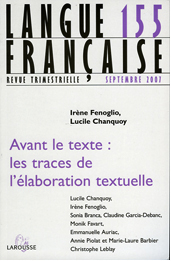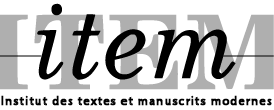
30/09/2007
Langue Française N°155
Ce numéro de Langue Française trouve son origine dans une réflexion menée entre psycholinguistes, linguistes et généticiens du texte, au sein du Groupement De Recherche « Approche pluridisciplinaire de la production verbale écrite » (GDR CNRS 2657, animé par D. Alamargot, MSHS, Poitiers).
Ce numéro présente une part des résultats des travaux (2003-2006) de l’axe 3 de ce GDR (dirigé par L. Chanquoy et I. Fenoglio) intitulé « Aides à la production verbale écrite, planification, versions successives et avant-texte ».
SOMMAIRE
Lucile Chanquoy et Irène Fenoglio
Avant-propos.
La notion d’avant-texte : point de rencontre pour une compréhension de l’écriture en acte
Irène Fenoglio
Du texte avant le texte. Formes génétiques et marques énonciatives de pré-visions textualisantes.
Sonia Branca-Rosoff et Claudine Gardia-Debanc
L’avant-texte à l’école primaire. Quelques jalons de 1850 à nos jours.
Monik Favart et Lucile Chanquoy
Les marques de cohésion comme outils privilégiés de la textualisation : une comparaison entre élèves de cm2 et adultes experts
Emmanuelle Auriac et Monik Favart
Passage d’un avant-texte au texte dans des écrits scolaires de type argumentatif.
Annie Piolat et Marie-Laure Barbier
De l’écriture elliptique estudiantine : analyse descriptive de prises de notes et de brouillons
Christophe Leblay
L’avant-texte comme texte sur le vif. Analyse génétique d’opérations d’écriture en temps réel.
Bibliographie thématique générale.
ABSTRACTS
Irène FENOGLIO : Text before the Text. Genetics forms and enunciative marks.
To conceive, to prepare, to plan ahead, to foresee, to anticipate, how can one define this procedure that initiates, launches, sets forth a text before it’s finalized, before it’s set free and lives its own life…textual life that is. This study is all about examining some of the parts that characterize this « pre-visual » phenomenon. It concerns textual genetics, framed within the chronological setting up of the various steps of the writing process. Everything is being considered in regards to the chronological pace of the writing in progress.
This paper shows that, although there are more or less visible limits between the various stratus for the « ‘avant texte », there never actually is a definite frontier between them and the on going text. Therefore, one must still describe the different aspects of porosity and their enunciative marks.
Sonia BRANCA-ROSOFF and Claudine GARCIA-DEBANC : L' »Avant-texte » at the Primary School Some Stakes between 1850 and to-day.
The teaching of writing proposed by the French school system has notably evolved since the middle of the 19th century. This article analyses how different levels in a written production (pragmatic, textual, syntactical, lexical, morphological, orthographical) are taken into account and worked at with the students. For each period, we will try to explain which linguistic operations connected to the “text process” are mainly taught, how this teaching is carried out, upon which level is focused the training suggested in the teacher’s syllabus, which activities are suggested for the students and practiced in the classrooms and which ones are left aside, which status is assigned to the drafts, which standard of the good text do these syllabus and exercises diffuse.
Monik FAVART et Lucile CHANQUOY : Functionality of cohesion devices in text production: a 5th graders and adults comparison.
This study investigates the progressive management of cohesion devices (anaphors, connectives and punctuation marks) in text production based on pre-texts. 5th graders and university students had to perform completion tasks for each type of mark. Results showed an effect of expertise on the quantitative and qualitative management of cohesion devices. The pattern of quantitative performance was the same for both groups, with higher performances for anaphors. Qualitative performances were different. Children met difficulties to manage punctuation and argumentative connectives, while adults highly diversified the sample of argumentative connectives they used. The diversification of connectives in narrative was weak, even in adults. These results specify the effects of expertise and textual structure on the management of cohesion devices. They highlight the development process of these three systems in connection with the process of textual planning.
Emmanuelle AURIAC et Monik FAVART : Transfer from pre-text to text in scholar argumentative texts
The generative process is studied through the argumentative writing activities of 131 3rd and 4th graders children. Our data show that the increase of the number of ideas in pre-text depends on one hand on the linguistics abilities (connective capacity) or on a second hand on the pragmatics competencies (activation of dialogic links between ideas). In an other way, the principal result shoes that children choose preferentially the listing of pre-text rather than the linear writing of their ideas. However, the linear pre-text is a better writing context to produce better qualitative text. The quality of text stands on the length of production, the good scholar level and the transforming strategy to write the text from the first ideas generated in the pre-text.
Annie PIOLAT et Marie-Laure BARBIER : About elliptical writing in students: a descriptive analysis of their notetaking and drafting acitivities
The present study aims at describing « front-texts » produced by undergraduate students in psychology during their academic practices. Several types of fronts-texts (notes or drafts) were realized by each student in an experimental setup, on the one hand, and in a real situation of examination, on the other hand. By comparing the various productions, the objective is to track down the intellectual investment orienting the scriptural practices of fronts-texts produced by the students. Several dimensions were specifically studied: the management of the graphic space of the notes or drafts as well as the processes of lexical and syntactic conciseness used by the students. Thus, in spite of the different contexts and goals of the productions for the students, these “front-texts” presented comparable characteristics for page formatting. Thus, the students did not change radically their abbreviated processes for notetaking and drafts’ production.
Christophe LEBLAY : Foretext as real life text. Writing operations in real time.
During the last two decades innovative approaches affecting writing production have been introduced in the areas like linguistics (enunciative grounds, genetic criticism) and technologies. Contributions made by these approaches are major and they keep continuing to offer a possibility for teachers to modify their teaching practices. In this article, it is a question of observing a real-time film of writing to glide in front of our eyes. The written productions are made by a restricted target group of Finnish students of French as a foreign language. The aim of this research is to demonstrate what really is happening during the writing process. The research aims at applying these theoretical approaches in order to find out to what extent it is possible to generalize the operations of writing : in this way reoriented activity of writing does not be satisfied with the final text but with its foretext.

















